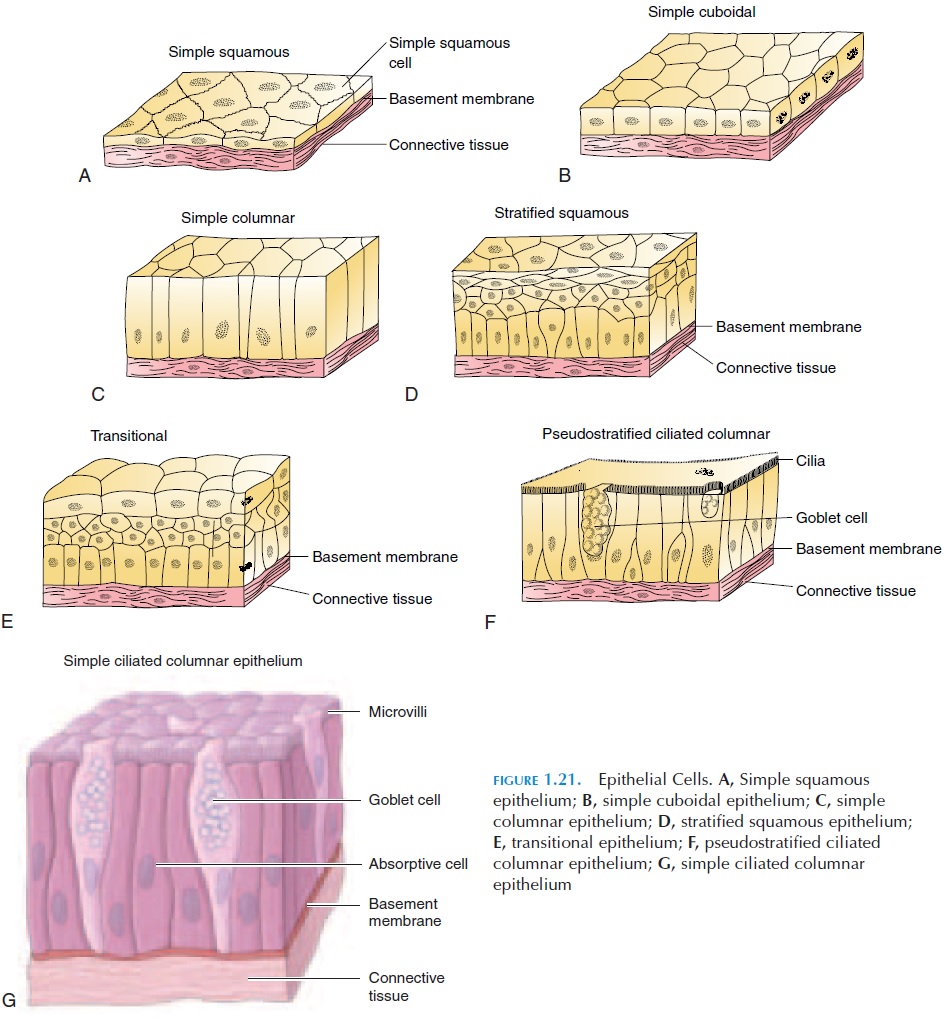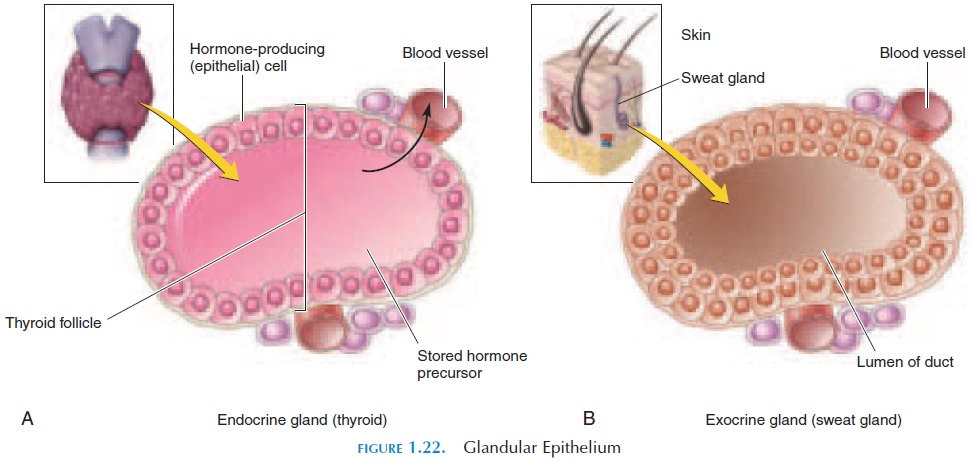Chapter: The Massage Connection ANATOMY AND PHYSIOLOGY : Introduction to Anatomy and Physiology
Epithelia Classification: Simple, Stratified, Glandular Epithelium
Epithelia Classification
As epithelia have common features as mentioned above, they are subtly modified to suit specific func-tions. Epithelia have been classified in accordance with the modifications in numbers of layers and with the shape of cell.
According to the number of layers, they are classi-fied as simple epithelium (one layer) or stratifiedepithelium (multilayered). According to cell shape,epithelia are classified as squamous, cuboidal, tran-sitional, and columnar.
Simple Epithelium
Simple epithelium has only one layer of cells over the basement membrane. Being thin, epithelia are fragile and found only in areas inside the body that are rela-tively protected, such as the lining of the heart and blood vessels and the lining of body cavities. They are also found lining the digestive tract and in the ex-change surfaces of the lungs, where their thinness is an advantage for speedy absorption.
Stratified Epithelium
A stratified epithelium has many layers and forms an effective protection from mechanical and chemical stress. They are found in the skin and lining the open-ings of lumens such as the mouth, anus, vagina, and urethra. The squamous, cuboidal, and columnar ep-ithelium may be simple or stratified.
Squamous Epithelium
The squamous epithelium consists of cells that are flat and thin and somewhat irregular in shape. Sim-ple squamous epithelium (see Figure 1.21A) isfound in protected regions (being thin and delicate) where absorption takes place or where friction must be minimal. A specific name is given to the epithe-lium that lines body cavities—mesothelium. The simple epithelium lining blood vessels and heart are called endothelium.

A stratified squamous epithelium has many lay-ers. The skin is a good example. In areas such as the skin, where the barrier formed by the epithelium also protects the body from dehydration, the most super-ficial layers are packed with a protein known as ker-atin. Such epithelia are referred to as keratinized; those without keratin are said to be nonkeratinized.
Cuboidal Epithelium
Cuboidal epithelium (see Figure 1.21B), as the name suggests, appear like a cube in section. They are found in areas where absorption or secretion takes place, such as the pancreas, salivary glands, and thy-roid glands. Stratified cuboidal epithelia are rare and found in the large ducts of the mammary glands and sweat glands.
Transitional Epithelium
Transitional epithelium (see Figure 1.21E) is the type of epithelium in which the cells seem to change shape. They are found in the lining of the urinary bladder. When the bladder is full, the cells are stretched and appear flat. When the bladder is empty, the cells appear multilayered.
Columnar Epithelium
The cells of columnar epithelium (see Figure 1.21C) appear as if they are columns—long and slender. These cells are found in regions where absorption or secretion occurs. Some columnar epithelia, such as those in the respiratory tract, appear to be in layers, but they actually are not. These are referred to as pseudostratified columnar epithelium (see Figure1.21F). In the respiratory tract, these epithelia also have cilia and are an example of ciliated epithe-lium.
Glandular Epithelium
Many epithelia that have cells that produce secre-tions are known as glandular epithelium (see Figure 1.22). The structures lined with glandular epithelium are known asglands. Two types of glands—the exo-crine and endocrine—exist in the body.

The exocrine glands release secretions on the ep-ithelial surface. Tubes, known as ducts, usually con-vey the secretions to the surface. Tear glands, sweat glands, and salivary glands are a few examples. The secretions may be released from the cell by exocyto-sis (merocrine secretion); by the apical region of the cell, packed with vesicles being detached (apocrinesecretion); or by the entire cell rupturing and releas-ing the contents (holocrine secretion). Merocrine secretion is the most common. Apocrine secretion is found in sweat glands in the armpit. Holocrine secre-tion is used by sebaceous glands near the hair folli-cles.
Exocrine glands are classified according to the type of secretion they produce. They are classified as serous glands if they secrete a watery secretion con-taining enzymes and mucous glands if they secrete the slippery, lubricating, glycoprotein—mucus. Some glands are mixed and secrete both serous and mucus secretions.
The glands may be either unicellular—just one se-cretory cell in the epithelia or multicellular, forming simple or more complex tubes that secrete.
The endocrine glands secrete their products di-rectly into the blood. The thyroid gland, pituitary gland, adrenal glands are a few examples of en-docrine glands.
Related Topics